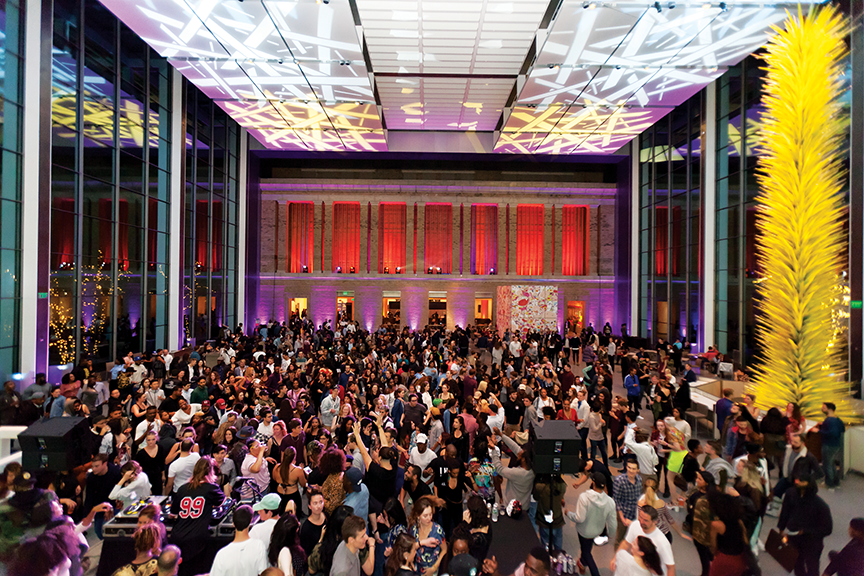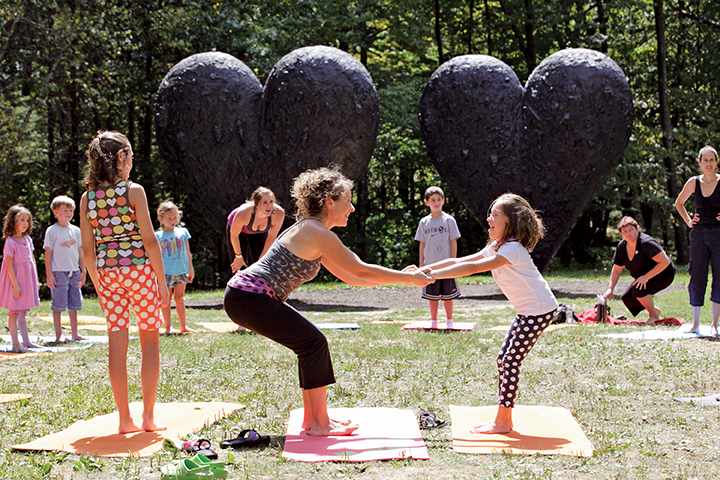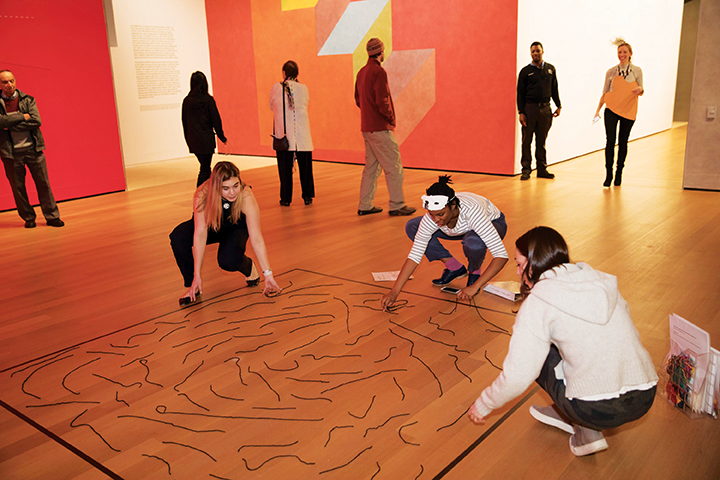“Welcome!” New England Museums Throw Open Their Doors to Engage New Audiences

Decades ago, when I entered an art museum with my newborn sleeping in a baby carriage, I was seen as a security risk and asked to leave. “People steal things, you know,” said the director. He explained his concerns: I might slash a painting out of its frame, stash it in the baby carriage and disguise the stolen goods as a well-bundled infant. The message was unmistakable: we were not welcome.
Today, flip that experience 180 degrees as art museums throw open their doors to say “Welcome!” with imaginative ways to accommodate, entice, educate and entertain. Perhaps to counterbalance a general decline in museum attendance, an emphasis on accessibility and engagement in art museums is on the rise.
The Worcester Art Museum and the Davis Museum schedule Stroller Tours, with educators guiding gallery talks to include toddlers in the experience, and the Smith College Museum of Art provides artful adventures for toddlers and caregivers together. Yet Museum and Me: Playdates with Art at the New Britain Museum of American Art stands among the most ambitious for visitors ages newborn to 18 or 24 months (“before they start running”). Through guided gallery explorations and sensory play sessions, parents learn ways to share art with their infants, recognizing and responding to signs of visual stimulation. And when infants grow up, they graduate to art projects aimed to inspire lively toddlers.
Museums also increasingly accommodate older visitors including extending access to people with Alzheimer’s (and other dementias). Hidden Treasures was developed at the Fitchburg Art Museum in collaboration with the Highlands, a Life Care Centers of America Community, and the Farnsworth Museum of Art holds a monthly Memory Gallery for adults with memory loss and their care partners, combining gallery tours with social gatherings.
At the Currier Museum of Art, a monthly Alzheimer’s Café offers dementia sufferers and caregivers a safe place to enjoy art together. During a typical two-hour session, participants socialize and then look at art in a classroom, while a trained educator leads a discussion. Then, participants visit the galleries to engage with at least one work of art. “I choose works that are not super abstract, but have recognizable images such as landscapes and genre scenes,” said Lynn Thomson, manager of community education and museum outreach. This year, the Currier piloted a new program for parents whose children suffer from substance abuse. Developed with Partnership for Drug-Free Kids, the Art of Hope provides mentoring and resources for parents impacted by their children’s addiction and structures opportunities for parents to find solace in art.
Responding to the idea of the museum as an art-filled safe haven, the Isabella Stewart Gardner Museum invites visual artists, poets, musicians and a range of creative thinkers to design sanctuary-inspired experiences. “Tours in the Sanctuary Series are experimental and experiential,” says Corinne Zimmerman, director of visitor learning. Led by Zimmerman, the Silent Tour explores communication without words, using drawing, gesture and writing. The Slow-Looking Tour allows people to slow down and forge deeper connections with each other as well as with a single work of art. While the Silent Tour entails no speaking, a Blind Field Shuttle Walk at the Bowdoin College Museum of Art demands no peeking. Social practice artist Carmen Papalia leads an eyes-closed tour of the college quad early in May, in conjunction with the exhibition Second Sight: The Paradox of Vision in Contemporary Art.
At MASS MoCA, James Turrell designed galleries to house immersive, light-based sculptures in his Ganzfeld series. German for “entire visual field,” Ganzfeld describes the effect of navigating through dense fog or blizzard whiteout—and Turrell’s carefully orchestrated chromatic effects enhance that visual disorientation. Timed tickets help organize small groups to venture into the space to be enveloped in color and experience its full perceptual significance. In other galleries, visitors don goggles and gloves to fly through Laurie Anderson’s virtual reality. Adding athletics to aesthetics, MASS MoCA commissioned North Adams artist Mary Lum to create a large-scale mural for a bike tunnel that passes through the museum’s ground floor, to connect local bike trails.

Offering another kind of push, with physical activity in a seasonal adventure, the deCordova Sculpture Park and Museum organizes snowshoe tours of the park on Saturdays (when the ground is sufficiently snow-covered). The 90-minute tours are led by an art-minded museum guide plus a guide from Eastern Mountain Sports, who helps participants learn to use snowshoes and trek between sculptures scattered around the grounds. Guides note that sculptures with layers, such as Ursula von Rydingsvard’s ence pence, seem transformed in a snow-covered landscape, and Jim Dine’s Two Big Black Hearts is also particularly beautiful with a crest of snow. In the summer, on Sundays, they offer yoga in the park.
Art museums are also extending their hours for after-hours parties. Late Nites at the Museum of Fine Arts, Boston entice the most energetic aesthetic night owls, with activities extending overnight. “Something for everyone” seems an understatement for the abundance on offer: dancing, DJs and pop-up performances, as well as hands-on art projects related to current exhibits. The monthly Art After Dark at the Newport Art Museum includes talks, film screenings, gallery games, music and drinks, but the museum also offers an opportunity to step back in time to the Gilded Age in an interactive Murder Mystery. Housed in an 1864 Arts and Crafts Stick Style mansion designed by Richard Morris Hunt, the museum becomes the perfect setting for finding clues, interrogating a cast of characters dressed in period costumes and determining “whodunit.“

The Yale University Art Gallery initiated a creative do-it-yourself approach with a Costume Ball: Plaster, Paper, Wood, and Wire to celebrate their spring exhibitions. Like latter-day Cinderellas, visitors invent costumes using plaster, paper, wood and wire (instead of glass slippers and pumpkins) for an evening of participatory studio activities, talks and performances.
BrainyArts at the University of Maine Museum of Art also taps visitors’ inventiveness. The series of after-hours Arts Trivia Nights began in discussions between museum director and curator George Kinghorn and education coordinator Kat Johnson on how to get people “thinking about the art world, thinking about art history, thinking about the art collection.” For the second season, the museum partnered with community arts organizations: Launchpad (an Arts Incubator organization) for visual arts; the Bangor Symphony Orchestra for the music-themed session; the Penobscot Theatre Company and ImprovAcadia combined for theater-trivia night; and for dance trivia, the Bangor Ballet. Each evening includes a Team Challenge with four rounds of four questions and an Individual Creative Challenge in which contestants create a work of art and the crowd declares the winner.
Art on exhibit becomes integral to the Ekphrastic Poetry Reading at the Robert Hull Fleming Museum of Art and Anthropology. Written in response to works of visual art, the ekphrastic poetry is part of the Painted Word Poetry Series, a collaboration born in discussions between museum director Janie Cohen and poet and English professor Major Jackson, who curates the series. The Painted Word invites students and community members to write original poems inspired by art in the museum. Then, authors of selected poems read their work in the museum’s Marble Court and have their poems published in an illustrated booklet.
In an effort to help rewrite art history, the Clark Art Institute invited art lovers and art historians to participate in an all-day Wikipedia Edit-a-thon. This communal updating of Wikipedia entries on art and feminism—also incorporating information on the more than 50 women artists in the Clark’s permanent collection—included training sessions and tutorials and joined edit-a-thons around the world inspired by the New York–based organization, Art+Feminism. The Williams College Museum of Art encourages visitors to join the Reading Room: People’s Library by answering the question: What book is helping you understand the world right now? After visitors name their choice, the museum purchases the book, makes a nameplate honoring the person who identified it and adds the volume to the archive.
The Mead Art Museum at Amherst College goes further, allowing the public to help choose permanent acquisitions. Students enrolled in Collecting 101: Acquiring Art for the Mead studied art and the art market and then searched for contemporary art prints in New York City. Breaking into four teams, students selected prints, prepared proposals and advocated for their choices in a public event at which every person who attended had a vote. Paired self-portraits by Shivangi Ladha and Cedar Kirwin tallied up the most votes, closely followed by William Villalongo’s screenprint commenting on recent and historical racism. In a fairy-godmother turn of events, the program’s benefactor increased the acquisitions budget, and the museum acquired three publically approved prints.
At a recent exhibit of work by Honoré Sharrer, the Smith College Museum of Art urged visitors to invent stories and insert themselves into the artwork. The painting Music for a Ballerina hung next to a vintage typewriter, with suggestions on writing stories responding to the imagery plus tips on typewriter use. And a reproduction of the same painting, vastly enlarged to over life-sized but minus the central figure of the ballerina, was installed as a selfie wall, offering a way to plunge into the middle of Sharrer’s surrealistic world. In a realm where cameras once could not click, selfies now rule.
Laura Holland is a senior lecturer at the University of Massachusetts Amherst.
CT
New Britain Museum
of American Art
New Britain, CT; nbmaa.org
Yale University Art Gallery
New Haven, CT; artgallery.yale.edu
ME
Bowdoin College
Museum of Art
Brunswick, ME;
bowdoin.edu/art-museum
Farnsworth Art Museum
Rockland, ME; farnsworthmuseum.org
University of Maine
Museum of Art
Bangor, ME; umma.umaine.edu
MA
Clark Art Institute
Williamstown, MA; clarkart.edu
Davis Museum at
Wellesley College
Wellesley, MA;
welleslley.edu/davismuseum
deCordova Sculpture Park
and Museum
Lincoln, MA; decordova.org
Fitchburg Art Museum
Fitchburg, MA; fitchburgartmuseum.org
Isabella Stewart Gardner Museum
Boston, MA; gardnermuseum.org
Mead Art Museum
Amherst, MA;
amherst.edu/museums/mead
Museum of Fine Arts, Boston
Boston, MA; mfa.org
Smith College Museum of Art
Northampton, MA; smith.edu/artmuseum
Williams College Museum of Art
Williamstown, MA; wcma.williams.edu
Worcester Art Museum
Worcester, MA; worcesterart.org
NH
Currier Museum of Art
Manchester, NH; currier.org
RI
Newport Art Museum
Newport, RI; newportartmuseum.org
VT
Fleming Museum of Art
Burlington, VT; flemingmuseum.org
